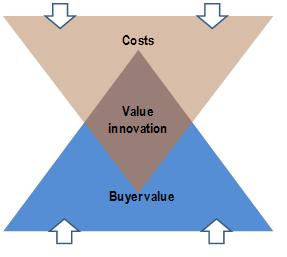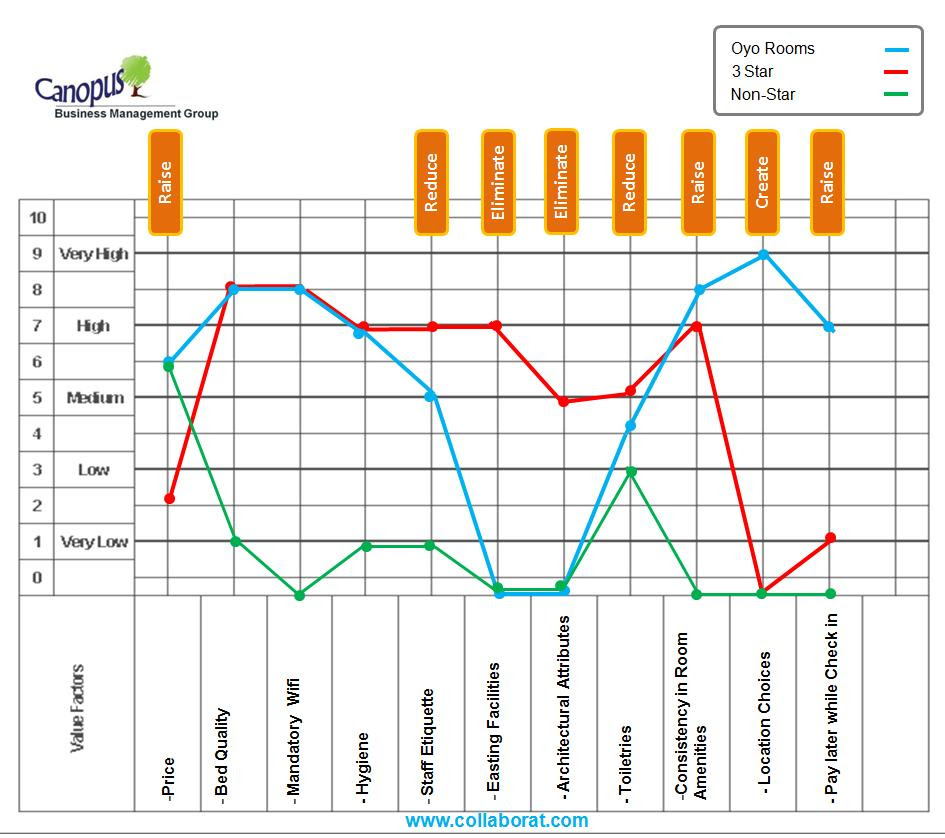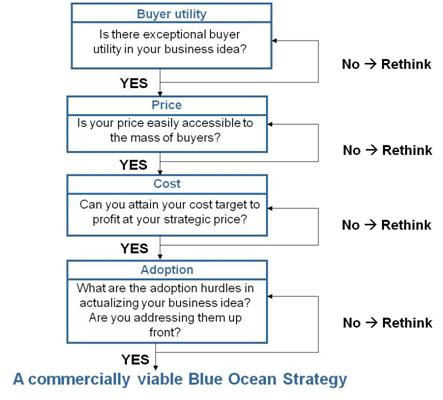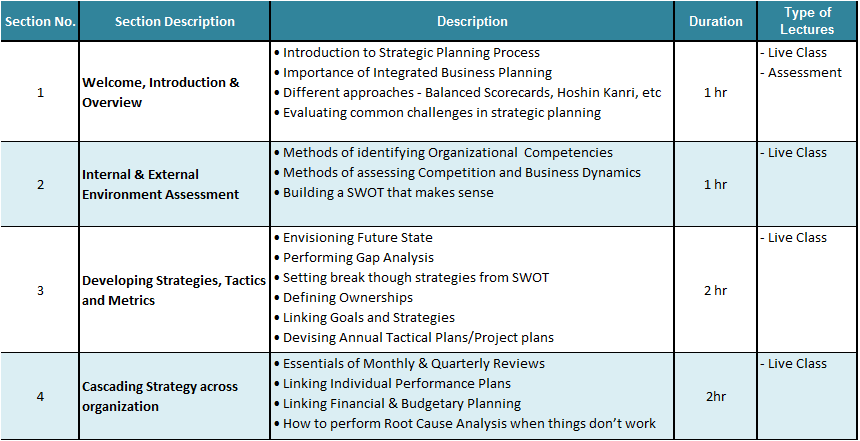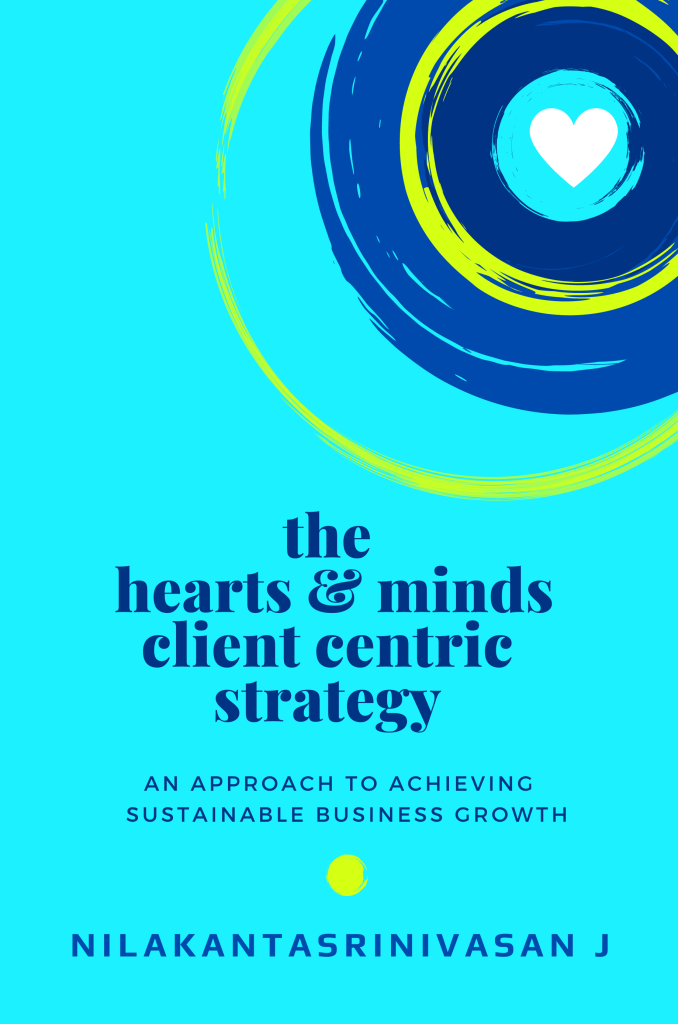In today’s chaotic and un-predictable business environment every organization in the private sector, government and non-profit is constantly being challenged to evolve. If they don’t, they perish. It’s like Darwin’s theory of evolution for organizations. The good news is that we have quite a few who have successfully evolved and become future fit.
We recently interviewed Gautam Borah to understand his perspective about innovation. Gautam is the author of the book “Monetising Innovation” published by Bloomsbury. He is an alumnus of Oxford and currently part of Customer Operation Team of an MNC. His website is www.gautamborah.com
Neil: What attracted you to Innovation?

Gautam: Innovation is about rediscovering, both at individual as well as organizational level to stay relevant. It’s about survival. From the Roman Empire to the Pan Am World Airways, there are umpteen examples of fall of the high and mighty all throughout the human history, from the biggest of the empires to the mightiest of the corporations. While much has been written on the reasons, delving deeper leads to the only one reason – their rate of innovation was not synchronous with what was exacted by the changing environment. At this point, always comes the eternal question – how can an organization remain Innovative?
In a broader sense, my interest in Innovation also stems from the same curiosity.
Neil: What does a company need to do to foster innovation and creativity?
Gautam: Let me draw a parallel here. How does an army win a battle? Take the example of the invincible army of Genghis Khan. The might of the Mongol army under Genghis Khan was due to the organization and execution. The organization part is important in this context which comprises an agile structure, discipline, speed, knowing the environment (opponent) well etc. It is the system that is imbibed over years which can create an army which can win war after war.
Similar is the case of Innovation. It entails a system that drives Innovation. This requires a conscious effort.
Neil: What is your big idea on Innovation?
Gautam: I have addressed the philosophy of this in the previous answer. An organization, to ensure sustained innovation needs to create a system that inspires Innovation. The idea is to work around the Innovation Drivers that ensures a continuous stream of Innovation rather than intermittent uncontrolled spurts.
Neil: What is your model of innovation and how is it different from other models?
Gautam: Let me start from where I ended the answer to the last question. The philosophy is to create a system that fosters sustainable Innovation. When anyone mentions an inspiring system like this, one needs to know the drivers which are constituents of the system.
Here, we are calling them as Innovation Drivers.
My book Monetising Innovation (Bloomsbury Publication) is exactly about this. The ICaM (Innovation Capability Model) model presented in the book lists 18 Innovation Drivers that an organization needs to nurture to remain Innovative.
I would put three points that differentiate this model – (a) It is pragmatic rather than theoretical – Few hundred practitioners and CXOs were interviewed / consulted backed up by primary and secondary research and testing to build a model that can be applied in a practice environment, (b) Measurable Model – Using this model, an organization can measure where it stands across the Innovation Drivers and align it’s resources accordingly to drive its Innovation initiatives, (c) Result oriented framework – The framework is built around the Innovation premise “Innovation = Creativity + Commercialization + Business Result”. Many a failure of Innovation initiatives in any organization is the lack of effective measurement. The framework takes care of that with clear focus on business results using defined metrics.
Neil: Can a company teach its people to be innovative?
Gautam: My belief is “Yes” – A company can teach it’s people to be innovative. It’s all about recruiting the right skill set, honing it to match entailed by changing needs and creating a culture that inspirit Innovation. “People” part in ICaM discusses this detail in my book Monetising Innovation.
Neil: What is one big change that you want to see in a company to become innovative?
Gautam: If I must, I shall urge a company to shift from sporadic Innovation (which is uncontrolled) to systemised or structured Innovation (where you know what is driving or retarding it). The second important point is to differentiate between creativity (which is just idea generation) and Innovation (which is Creativity + Commercialization + Business Result).
Follow Gautam on twitter @gautamkborah. His website is www.gautamborah.com
To know more about the book, click on the image below.
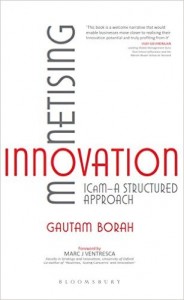
I checked into a budget hotel and surprisingly everything was fine. When you book in an unbranded hotel, you are mentally prepared for leaky bathrooms, dirty beds, noisy air conditioners, etc.
But this time I booked my hotel room through Oyo Rooms, an aggregator of budget hotels in India. I’m sure you have already heard of Oyo Rooms. Started in 2013, it offers a network of branded budget hotels in India. In a very short span, Oyo Rooms has built a network of 2500+ hotels.
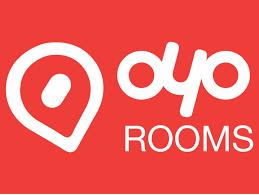
In a matter of 3 weeks I stayed in Oyo Rooms in 3 different cities across India and I can certainly tell you that consistent quality is one thing that stands apart.
As a practitioner of Blue Ocean Strategy, I can see in this success, Value Innovation at work.
Value Innovation is a central concept in Blue Ocean Strategy. Through this concept organizations can unlock immense value to customers and simultaneously reduce the cost to the company. Value is usually attached to tangible things, but in reality, true value to customers need not be something path breaking. For example, by providing valet parking when you visit your bank’s down town branch, the bank can unlock huge value. But valet parking is such a silly and trivial aspect as against bank’s core product features that bank may see it as a distraction rather than value add.
(Above illustrated from Blue Ocean Strategy book)
Oyo brings ‘predictability’ as a key value that is usually missing with budget hospitality sector.
For prices as low as Rs.1000 per night, one gets free wifi, breakfast, flatscreen TVs, spotless white bed linen of a certain thread count, branded toiletries, 6-inch shower heads, a beverage tray, etc.,
Oyo also have room recommendations for solo travelers, couples, business travelers, women, etc.
Most of what you see in 3 star hotels such as fancy lobbies, elegant lounges, superior spa, etc. are often not the reason one chooses such hotels. Instead, basic hygiene, descent environment and predictable service drive customers to such branded hotels. The core to Oyo’s value innovation is to eliminate fancy aspects but retain aspects such as hygiene and predictability.
As a result, Oyo is able to drastically reduce the price per room (in comparison to 3 Star) and simultaneously but disproportionally increase the value to customer.
Oyo unlocks disproportionate business by attracting 3 star customers to trade down while non-star customers trade up to Oyo Rooms. Thus Oyo is capturing the both segment of customers!
To understand this better, let’s look at that strategy canvas, a critical tool of Blue Ocean Strategy used to create value innovation.
Strategy Canvas is one of the simplest, yet most powerful tools of Blue Ocean Strategy to visually identify the factors that any given industry is competing on. It helps to strategize how differentiation can be carved out as against competition. Each factor in the graph that unlocks value to customers is rated in the 10 point scale and compared against competition or industry strategic groups.
Oyo is a evident case of Blue Ocean because in comparison to either the existing star hotels or non-star hotels, Oyo has chosen to differentiate themselves by Eliminating some existing features, Reducing some features, Raising some and simultaneously Creating few new features. Traditionally companies focus on outserving the competition but Blue Ocean advocates differentiation through Elimination, Reduction, Raising and Creating.
I should confess that Oyo Rooms isn’t the first hotel ever to try this. There are many such as Formula1 Hotels, Ginger Hotels, etc. which have attempted to create a differentiation. I should credit Oyo not only for their excellence in execution, but also in striving to find innovative ways to keep the financials intact. For example, Ginger Hotels unsuccessfully tried to target the same segment despite having own/leased properties. On the other hand, Oyo Rooms has positioned itself as an aggregator brand rather than a traditional hotel chain. This has helped them to stay fit on capital and operational costs, and more importantly, ramp up in no time.
In order to create Blue Ocean in your own industry, consider the steps involved in creating Blue Ocean are illustrated in the below image:
(Above illustrated from Blue Ocean Strategy book)
You can learn more about the 6 paths to create exceptional buyer utility here.
Oyo Rooms is already facing the heat of competition of me-too brands. In order to sustain position, Oyo will have to constantly refine its offering to unlock value for customers. For example, I found that none of the 3 Oyo Rooms I stayed in has overnight laundry or iron box on the house. I can’t land up for client meeting in wrinkled outfit J. Similarly none of them have tea bags and kettles in the room and room service didn’t start before 8 AM.
Super imposing the Blue Ocean Strategy and its framework is only an attempt to learn how innovations can become predictable rather than a chance of luck or brilliance of genius. If you are now tickled to create a blue ocean, this article has achieved its purpose and so would I.
Interview: Organizational Strategy Challenges & Solutions
Extract of an interview of Neil published in Consultants Review Magazine about Organizational Strategy Challenges and Solutions
The economy stands at a crucial juncture now and constant endeavour for excellence and accuracy has come to be more pivotal than ever before.
The goal now is to focus on industry needs with a futuristic perspective, in order to foresee the norms of tomorrow. Canopus Business Management Group (CBMG) is a business services firm that focuses on strategy implementation & business transformation to make them future fit, and it is this approach that has brought them a fair amount of success already. Incepted in 2009, by the MIT educated Nilakantasrinivasan Janakiraman(Neil), CBMG started operations in Chennai, with the vision of bringing something fresh to the consulting space. Read More
We are delighted and honored to share that Consultants Review Magazine has selected Canopus Business Management Group among 25 Most Promising Management & Strategy Consultants in India.
An extract from May 2015 Issue:
“Over the past decade the corporate world has witnessed dramatic shifts in its form, fi nance, marketing,HR,and outsourcing have all faced the change that is slowly gripping the entire sector. Devising business strategies, global marketing,and innovating new products now form the core of developing a business. In this changing arena, defi ning management & strategy consultants only in the role of advisors would be an understatement. Read More.
Most Promising Management & Strategy Consultant
Course Highlights
- Learn about the basic elements of good goal and strategy plan
- Assess where your organization stands in strategy execution
- Understand what it takes to move the plan from paper to implementation
- Create a broad outline of information, resources and people required
Course Description
Annual Goal and Strategy Setting is a very complex process and is largely driven by the company’s culture and tradition. But there are few important elements to this exercise, without which the whole exercise will be waste. In this course, you will learn about the basic elements of good goal and strategy planning exercise, assess where your organization stands when it comes to strategy execution, so that you can create a broad outline to pull your entire organization together around a single game plan.
What makes this course unique?
In my personal experience, many organizations do this activity like any other team outing and end up missing several important elements which impacts the organization’s chances of meeting their goals.
This is a no-nonsense crash course with practical approach to lead an annual goal and strategy session.
Who should take this course?
If you are responsible for coordinating Annual Goal and Strategy Planning for your organization or your department, then you will certainly find this course useful.
- Finance Managers
- Strategy Team Members
- Business Heads
- Analysts
Course Start Date: March 15, 2015
Course Package:
- 1 Week of study
- 6 Hour lecture covered in 3 days. 2 Hours of commitment each day
- Assess where your organization stands when it comes to strategy execution
Course Fees: Rs.5000
Make Payment here
It is common to gather the voice of customers (VOC) to understand their changing needs. This helps any organization to better serve its customers. By learning about specific needs; products and services can be customized. Thus over a period of time, organizations build the know-how of segmenting customers very precisely. This helps in creating and pruning targeted marketing campaigns, in addition to customized products and services. Such an approach is a staple component of most organization’s customer acquisition & management strategy.
But a serious flip-side to such an approach is that the cost of acquisition can become higher.
- Organizations need to run targeted marketing campaigns for each segment.
- With time, number of sub-segments will increase.
- This will lead to increase in the cost of production.
- Additional design costs, incurred for customization, will sky-rocket.
- After all, customization works against the scale of economy.
More importantly, customization puts organizations on a trajectory of high cost of reversal. What if, changing dynamics lead to change in customer needs that you cannot easily fulfill? Consider the example of Bajaj Auto & Kinetic Motors: ‘Cheetak’ & ‘Kinetic Honda’ were their flagship products. Around the turn of the century; stringent pollution norms, and changing demographics of customers (decrease in the average age for 2 wheeler users) led to the downfall and eventual extinction of these products. While these are just product lines, there are examples of large corporations that have disappeared too.
What many companies miss; is the opportunity to attract buyers who don’t resemble their existing customer segments. Their rationale, such inclusions distorts their well defined customer segments. But, in reality, they miss the opportunity to reach beyond existing demand. With shrinking markets, this is imperative for many industries today.
More importantly, knowing what your customers want will only help you serve them better. Never will it help you attract new buyers. Thus, to grow your business, organizations need to look at potential non-customers; understand their common needs and rework offerings to attract them.
To take this one step forward, let’s understand the 3 categories of non-customers as per Prof. Chan Kim and Prof. Renee Mauborgne of INSEAD as described in Blue Ocean Strategy:
Reluctant Customers
- Customers who minimally buy from your industry/company and out of necessity.
Strong Detractors
- Non-customers who refuse to use your industry/company offerings due to past bad experiences or because they can’t afford.
True Non-customers
- Non-customers who have never thought of your industry/company offerings as an option or you aren’t aware of such customers.
Let us learn this concept with an example from the cable TV industry.
A major DTH provider in India, TATA Sky and many other DTH operators in India, have reached out beyond their existing market demand (of just offering TV channels), and thus, have grown disproportionately.
There are many such examples of enterprises in B2B and B2C that have focused on common needs of non-customers. They developed simple products and services, and have successfully captured new markets. The story of how Gillette tapped retail shaving market beyond supplying blades to saloons, way back in 1900′s, is a standing example from yesteryear.
If you wish to create a growth strategy based on non-customers, then your organization’s Strategic Planning Process should drive the following
- Shift away from segmenting existing customers, and addressing needs by customization. Rather, look at common needs of non-customers and address them as a whole.
- List down non-customers for your industry/organization, and identify their common needs.
- Most importantly, prioritize these common needs based on market potential and opportunity.
- Revisit existing product and services to tap new demand.
- Integrate this strategic intent with organization’s overall strategy execution.
- Set up a mechanism to constantly tap the voice of non-customers too.
Thus, the approach is straight forward, but it would require an ample commitment from the leadership to divert their attention towards consciously targeting non-customers rather than customers!
Blue Ocean strategy shapes strategic structure to create new demand and generate high growth for the company. To create such a strategy, there are a set of analytical tools and frameworks used in formulating and executing it. The first and foremost tool in value innovation and creation of blue ocean strategy is the strategy canvas.
Also known as Snake Plot, the basic component of strategy canvas is value curve that is nothing but a graphical form of company & competition’s current state of play in the known market. This mapping makes us understand where the competition is currently focusing, the factors that the industry competes in selling its products, service and delivery and what the customers receive from the existing competitive offering on the market. Strategy canvas helps us to reconstruct the buyer value essentials by questioning its existing industry’s strategy and business model by shifting our focus from competitors to alternatives and from customers to non-customers of the industry thus making a trade-off between value and cost. It tells the story in one page.
How to read a value curve of strategy canvas?
The horizontal axis captures the key factors the industry competes on and invests in. The vertical axis of the strategy canvas is a rating scale that captures the current state of play of key competing factors
How strategy canvas is created?
Key factors are those value creating components a company invests in resources, processes and capabilities and involves strategic choices and impacts strategic purpose. To know the key elements the team has to do extensive research and analysis within the organization as well as outside, interactions with customers about the product, service and delivery. After determining the key elements, the team has to give rating to these elements. The rating given may be relatively low, low, medium, high, relatively high etc. The rating given to each key factor must be fair and unbiased. Let us consider an example from the professional development and education sector.
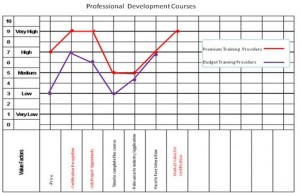
The above graphical depiction shows the professional development courses offered by the premium training providers and budget training providers. The horizontal axis has the key factor such as price, certification recognition, job/project opportunity, time to complete this course, relevance to industry/application, face to face interaction and market value for certification. The vertical axis shows the relative value buyers receive across all these key competing factors. For example, premium providers price their product/service higher than budget providers and so on.
Thus by preparing the strategic canvas the company is ready to explore how to redraw its strategy to create blue ocean. It forms the basis of value creation and value capture for a company and helps in creating value innovation.
The strategic canvas can be constructed for different strategic groups (organizations that differentiate themselves by pricing) or between the organization and its competitors.
The primary difference is in the application of strategic canvas after its creation. In case of Blue Ocean Strategy, the next step is to include substitutes and alternatives in the canvas rather than mean competitors within the industry. After inclusion, the team uses the 4 action framework to create Blue Oceans.
In simple terms, strategy is the ‘how’ part of achieving goals under certain conditions, constraints, restrictions and assumptions. In ancient Greece the word ‘strategos’ was referred to as the role of an individual – a general in command of an Army. A good strategy should equally focus on execution & communication. In Blue Ocean Strategy, there are three simple characteristics or yard stick used to evaluate strategies – Focus, Divergence and Compelling tagline.
In order to understand these characteristics, knowledge of Blue Ocean Strategy Canvas is essential. You can learn more about Strategy Canvas here.
To unlock a blue ocean, the company’s value curve should depict these three characteristics.
Focus
A good strategy should have a strong focus, and a company’s strategic profile should clearly show it.
A company should not diffuse its efforts on all the factors of the competition, instead focus on the key factors on strategy canvas.
Focus is the key factors where the company has raised its performance or standard in comparison to industry peers to differentiate them. Consider the Indian airline industry where in the early 2000 industry performance was punctuated with late departures & arrivals, coupled with southward moving prices. Indigo Airline’s strategy focused on the factor of timely departure & arrival. It ensured that all its resources are diverted to achieving this goal. Unlike like other airlines like Kingfisher, Jet Airways &p; Indian Airlines it didn’t focus on hot & gourmet cuisine or passenger entertainment, etc
Thus Indigo’s relentless focus on the key factor (On time Depature & Arrival) that it raised on the strategy canvas has not only profitable, but helped it built a loyal customer base in a short period.
Thus the first characteristic, Focus is all about execution of key factors that the organization has raised in its strategic canvas. Customers will have to feel the differentiation.
Divergence
The value curve of blue ocean strategy always stands apart from the competitors. Reactively formed strategies tries to keep up with the competition, thus loosing uniqueness.
Divergence helps differentiating company from the industry’s average profile and helps them to achieve a leap in value on strategy canvas, such as low-cost business model. It makes the company to stand apart from the rest.
Divergence is where the company has reduced or eliminated certain factors in strategy canvas which will have an impact on the cost without affecting product and service quality and voice of the customer.
Indigo Airlines created a strategy that aimed to differentiate itself from Jet, Sahara, Air India. As a result, it created a service that is better on timely departure & arrival, but reduced & eliminated factors like food, entertainment, etc. thereby creating a value curve on strategy canvas.
Free Download
Get your copy of E-Book “The Hearts & Minds Client Centric Strategy” on how to achieve sustainable business growth . It contains cases, examples, detailed implementation approach along with ideas to achieve sustainable growth, especially for B2B firms. (Pages : 51)
Divergence is creates differentiation not by merely providing ‘more’ but instead by not providing or providing ‘less’. It drives the company to resist the old logic of benchmarking the competitors in the industry and look across alternatives.
Compelling tagline
A good strategy has a clear-cut and easy to communicate tagline. Unless the customers and employees aren’t informed about the strategy, it’s unlikely they would appreciate them. ‘Tagline’, a term that’s close to the heart of marketing folks is also evolved from the strategy canvas of the Blue Ocean Strategy. In simple words, it is a factor(s) which is newly created by the organization and not present in the competitors of the industry.
A strong and truthful tagline on the strategy canvas will give clear message on cost-value offering and create interest to the customers. The effectiveness and strength of a strategy will be determined by a strong tagline.
IndiGo airline created a tagline on strategy canvas by advertising that ‘We believe that we can offer the lowest fares by staying focused, which keeps our costs down without cutting corners or compromising on things that matter.’ They don’t miss to mention about their on-time arrivals performance.
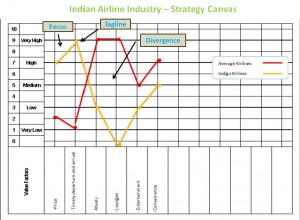
Thus the three characteristics of blue ocean strategy will guide the company to achieve a breakthrough in value for both the customers and for themselves. Focus will help to retain customers, divergence will reduce the cost to the company and the compelling tagline will invite customers to the company.
To break from competition, a organization has to reconstruct the market boundary which is the first and foremost principle in creating blue ocean strategy. There are six basic approaches to reconstruct market boundaries, also known as Six Paths Framework. These paths challenge the conventional approach of the organization in strategy formulation to work within its boundaries, but instead break out of the known boundaries. This helps them to move out of red oceans and create blue oceans.
The six paths framework in formulating blue ocean strategy are (1) Look across alternative industries, (2) Look across strategic groups within industry, (3)Look across buyer groups, (4) Look across complementary product and service offerings, (5)Look across the functional-emotional orientation of an industry and (5)Look across time to shape trends.
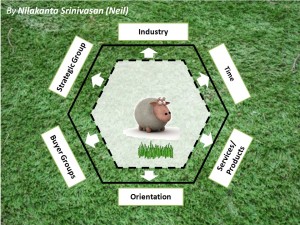
6 paths framework blue ocean strategy
Following are the six paths framework involved in formulating the blue ocean strategy.
Path 1: Look across alternative industries
Organizations compete not only within the industries but also with organizations in other industries which produce alternative product and services to their industry.
One of the biggest limitations we put on our organization is to assume that our products/services compete in a defined and unchanging industry with a very narrow view of the environment.
The first path in formulating the blue ocean strategy is to find the alternative industries to your industry’
In order to understand this path let us first understand difference between substitute and alternative:
- Substitutes are products or services that have different forms but offer the same functionality or core utility.
- Alternatives are products or services that have different functions and forms but the same purpose.
Let us consider an example from entertainment industry. The function of this industry is to provide entertainment and the purpose of this industry is relax, rewind, de-stress, experience and fun. The substitutes to this industry are CDs, TV, stage shows, etc. But the alternatives to this industry include visiting a mall, library, hobby centre, etc., all of which serves the same purpose.
Thus by focusing on the key factors that lead buyers to trade across alternative industries and by eliminating or reducing everything else, you can create a blue ocean of new market space.
Let us take the case of pro-biotic drink Yakult. It competes with health drinks, juice brands, at the same time it competes with pharma industry. However, both health drinks producers & pharma brands don’t consider Yakult as their competition. Thus Yakult has created a blue ocean for itself across industries.
Path 2: Look across strategic groups
Strategic groups within Industries are group of organizations within an industry that pursue a similar strategy. Strategic groups include a hierarchical order built on two dimensions, price and performance. Thus by looking across strategic groups, an organization has to find why do buyers trade up for the higher group, and why do they trade down for the lower one?
TATA chose not to compete with entry level strategic group of cars in India such as Maruti Omni, Maruti 800, Alto & Hyundai Santro. Instead it questioned the un-questioned notion that cars can’t be less than a lakh of Indian Rupees. It looked for factors which, Maruti 800 buyers would trade down or 2 wheeler buyers would trade up!
Path 3: Look across Buyer Groups
In most industries, competitors converge around a common definition of target buyer. However there are chain of buyers who are directly or indirectly involved in buying decisions, such as:
- Purchasers who pay for the product or service
- Actual users who use the products
- Influencers who have a role to play in decisions
- Intermediate buyers who are traders
- Regulators who influence the buying decisions
Thus blue ocean strategy is formulated by finding out who are the chain of buyers in your industry and which buyer group does your industry typically focus on? And if you shift the focus from one buyer group to another, how can you unlock new value?
Novodisk, a leading producer of insulin created blue ocean by focusing on diabetes patients instead of doctors & nurses who are traditionally targeted. Thus they created travel friendly, easy to use, hassle free, easy to set, fancy looking, pen like shots instead of syringes and insulin bottles.
Path 4: Look across complementary product and service offerings
An organization has to think about what happens before, during, and after your product/service is used by the consumers. In most industries, competitors converge within the boundary of their industry’s product and service offerings. By understanding the context in which your product or service is used and what happens before, during, and after, you can identify pain points (constraints) of the consumers, eliminate these pain points through a complementary product or service offering.
Philips saw that the biggest issue in brewing tea was not in the kettle itself but in the complementary product of water, which had to be boiled in the kettle. The issue was the lime scale found in tap water. Philips saw this as an opportunity and solved the major pain point of customer that related to water rather than their kettle by adding a mouth filter in the kettle that effectively captured the lime scale as the water was poured.
Path 5: Look across the functional-emotional orientation of an industry
Emotional Appeal to buyers refers to the emotional utility a buyer receives in the consumption or use of a product or service. Competition tends to converge on one of two possible basis of appeal. ‘What are the extras we offer that add to the cost of our product without enhancing functionality? By eliminating or reducing these factors, can we create a simpler, functional, lower-priced, lower-cost offering that would dramatically raise buyers’ value’. These are to be questioned in blue ocean strategic formulation.
Functional Appeal to buyers refers to the functional utility buyers receive from a business or product/service based on basic calculations of utility and price. Competition in an industry tends to converge on one of two possible basis of appeal. What emotional elements can we raise or create to infuse our commodity products with new life by adding a dose of emotion?
By understanding your industry focus on functionality or emotional appeal, you can either compete on emotional appeal by stripping functional elements or compete on functionality by adding emotional elements.
Fast Food producer, Subway uses emotional appeal to trade up its range of products which usually have more functional appeal rather than emotional. Fast food industry is driven by price and waiting time which are functional. This industry rarely competes on emotional appeal.
Path 6: Look across time
Many of us respond to trends in our industry at the point they are making an impact. In other words we create reactive strategies, which allow us to adapt to a changing environment. All industries are subject to external trends that affect their business over time. Instead of adapting incrementally and somewhat passively, one can gain insights into how the trend(s) will change value to customers and impact their organization’s business model.
To assess trends across time, three criteria are critical: the trend must be decisive to the business, irreversible and have a clear trajectory. By knowing what trends have a high probability of impacting your industry, are irreversible, and evolving in a clear trajectory, you can open up unprecedented customer utility.
Free Download
Get your copy of E-Book “The Hearts & Minds Client Centric Strategy” on how to achieve sustainable business growth . It contains cases, examples, detailed implementation approach along with ideas to achieve sustainable growth, especially for B2B firms. (Pages : 51)
When we look across these six paths at the commencement of our strategy formulation we find that this process helps us create new perspectives. Our thinking becomes more creative.
It seems simple, because it is. However, it’s when we actually start the process of looking across these six paths we find our assumptions start to break down and simultaneously we awaken to new perspectives about our organization and its industry. And it’s from this place that innovations and new opportunities are created.
‘Skyfall’ became the highest grossing film of all time at UK box office with earning nearly £103m. Global earnings of the 23rd Bond movie crossed $1.1Bn. This makes it the first film in the Bond franchise to reach that total and the highest-grossing film in Sony Pictures history. It is the 14th film to gross over $1Bn.
Traditionally, Bond movies have their own flavor of opening scene of gun barrel sequence, out of box gadgets, girls, glamour, interesting locations and of course suits, martinis and ruthless villains. If you have watched Skyfall, you will agree that it’s very different from other Bond movies.
How director Sam Mendes and writers, Neal Purvis, Robert Wade & John Logan consciously curved out a niche for this bond film that makes it stand out differently from others and yet amassed a box office fortune has been decoded here using ‘Blue Ocean Strategy’ perspective. Clearly, this film is a successful case of innovation using Blue OceN Strategy in creative businesses for us to learn from.
Blue Ocean Strategy is an approach for organizations to create new demand in an uncontested market space called “Blue Ocean”, rather than compete head-to-head with others in an existing industry. So it is an approach to innovate in the market.
Strategy Canvas is one of the simplest and yet most powerful tools of Blue Ocean Strategy to visually identify the factors that any given industry is competing on, where competitors stand and how a Blue Ocean Strategy/Innovation can be carved out of it.
I have considered created the Strategy Canvas of Skyfall and compared it with other bond movies.
The factors that are unique to bond movies and something that audiences generally expect from any bond movie have been listed in the X-axis under value factors. Each of them has been rated in a 10 point scale against known standards. For example, I would compare the value factor ‘Action’ of Bond movies with action in other movies and give it a rating. After completing the strategic canvas for Bond Movies, I repeated this exercise for Skyfall, in particular.
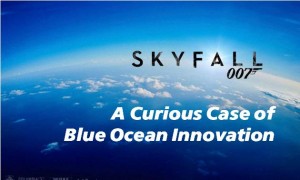
By comparing the strategic canvas, it is evident that Skyfall is very different in many aspects from other Bond movies.
In order to characterize the difference or uniqueness of Skyfall from other Bond movies, Blue Ocean Strategy prescribes 4 Actions Framework, aka ERRC. It is an acronym for Eliminate, Reduce, Raise and Create.
The 4 Actions Framework can be used to answer the following questions which in turn will help in creation of a Blue Ocean (in this case, Skyfall)
- What factors of other Bond Movies can be Eliminated?
- What factors of other Bond Movies can be Reduced/
- What factors of other Bond Movies can be Raised or Elevated?
- What factors of other Bond Movies can be Created or Added?
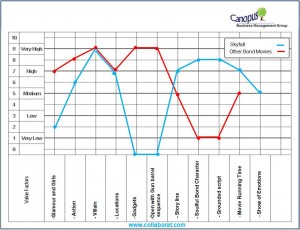
Why is Skyfall an innovation?
Eliminate
Use of ultra hi-tech Gadgets and unique gun barrel opening sequence, both of which are common to Bond movies have been eliminated all together. In Skyfall, hardly any ultra hi-tech gadgets are employed while the gun barrel sequence has been pushed to the last.
Reduce
Glamour, girls and action, three things that comes to our mind about Bond movies have been carefully compromised in Skyfall. While, there is a big risk in reducing these factors, as there is likely loss of identify, it has also made Skyfall stand out. The director and writers have carefully tread this path.
Free Download
Get your copy of E-Book “The Hearts & Minds Client Centric Strategy” on how to achieve sustainable business growth . It contains cases, examples, detailed implementation approach along with ideas to achieve sustainable growth, especially for B2B firms. (Pages : 51)
Raise
Storyline, soulful Bond character, grounded script and movie running time have been raised or elevated. Bond is always portrayed as a charismatic and shrewd super spy. But Skyfall portrays his early life, love for his parents, and relationship with mother like M in this film. It is noteworthy that Skyfall has a longest running time of all Bond movies with 146 mins. Most Bond movies average to 120 mins with few exceptions.
Create
Bond never shows emotions(other than love). He means business. But Skyfall centered on Bond’s personal life, the emotions he went through as a child and what his childhood and his mean to him. Thus by infusing emotions in the Bond character, has created an unique factor!
Unlike Avatar or Titanic which have over $2Bn of box-office earnings, a Skyfall does carry a baggage of being a Bond movie. Audiences have per-conceived expectations from Bond movies. That way, Skyfall is a curious case of successful innovation in creative businesses. Super imposing the Blue Ocean Strategy and its framework is only an attempt to learn how innovations can become predictable rather than a chance of luck or brilliance of genius!
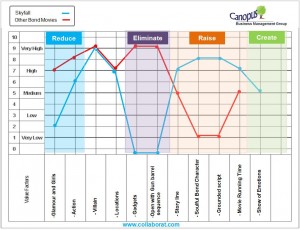
About the Author
Nilakantasrinivasan aka Neil helps a range of large enterprises in services and manufacturing, with particular emphasis on organization and functional strategy using Blue Ocean Strategy and Hoshin Kanri. He can be contacted at neil@collaborat.com.
Management of Strategies is a vicious cycle. Most organizations aggressively start them and progress till they hit execution roadblocks, they stumble and quit. By then, its time for the year’s performance evaluation so they scramble and fire fight to achieve their goals.
12 Step Strategic Management Cycle is a comprehensive approach that leverages the principles of Hoshin Kanri Policy Deployment and Blue Ocean Strategy. 12 steps mentioned below are followed sequentially, but many of them can be initiated concurrently.
1) Current Performance Assessment
Strategic management process of the coming year commences with a stock-taking exercise of current year’s performance. Most of information relating to current performance will be readily available, but the purpose of this exercise isn’t mere stock-taking. It goes beyond that to understand the lessons learned from current year, variation in performance and reasons for it. Therefore this exercise is reflective in nature.
2) Internal Environment Scanning
Internal environment plays a very critical role in our success. Quite often, leaders take internal challenges for granted. They feel that they can push their way through. Internal scanning is aimed at understanding changes in competencies/skills, mindsets, business models, associate satisfaction, attrition reasons, technological/infrastructure barriers, etc. Best way to scan the internal environment is through information research, interviews and focus group discussions.
3) External Environment Scanning
External environment plays an equally critical role in our success. Scanning of external environment is an evolved task in many organizations. There are industry research bodies, market subject matter experts, analyst reports, secondary information research information, commissioned studies undertaken by the organizations, etc. The only point I wish to highlight is the the voice of customers and more importantly the voice of non-customers.
4) SWOT Creation/Updation
SWOT is probably one of the oldest management tools. It is simple yet powerful. But it’s also the most abused tool. When I ask leaders to update their SWOTs, they avoid and prefer to delegate. But when I insist, they reluctantly get involved. In reality, the quality of SWOTs are unbearable. Most SWOTs are nothing but a journal of accomplishments and perceptions. But a good SWOT should be factual, frequently updated (at least yearly) and should be prepared with involvement for all stakeholders.
5) Goals Pre-work
Organizational goals have to be comprehensive and quantitative in nature. A facilitator plays a critical role in conducting pre-work exercise. Potential candidates for goals are collated, grouped, prioritized and selected through consensus.
6) Goals & Strategies Formulation
The real truth about most strategic plans is that there are no real strategies. Goals and strategies are interchangeably used. A good strategic plan should have 3~5 unique strategies derived from SWOT. Strategies answer the ‘How’ part and not the ‘What’.
7) Ownership
When goals are finalized, unique owners for each goal are also to be assigned. What differentiates between organizations that are successful with execution and others is their ability to create Individual Ownership and Shared Accountability (IOSA) in delivering organizational goals. ‘Catch-ball’ mechanism is a method adapted in Hoshin Kanri approach to drive this joint accountability for goals.
8) Strategic Projects Identification
Strategic Initiatives aka Strategic Projects are nothing but the most important projects that are require sponsorship to achieve specific stretch goals. So it starts with identifying stretch goals that cannot be accomplished by business-as-usual(BAU) means. These are good candidates for strategic projects. It is critical to ascertain ownership, measures of success, duration and sufficient sponsorship for each strategic project. Thus organizations are recommended to choose and run only a limited number of strategic projects. Those which don’t qualify to become strategic projects go into parking lot and are pursued in FIFO (First In First Out) approach. Prioritized strategic projects are funded, sponsored and resourced the most.
9) Cascading of Strategies
Strategies needs to be cascaded to grass-root level and this happens through deployment of strategic plans. Enterprise Strategic Plan needs to be cascaded to Organizational Strategic Plan (Business Unit level) and further to Functional Strategic Plan. Usually, most organizations cascade goals and metrics using Balance Score Card approach, but goals are only one aspect of strategy deployment.
10) Weekly Progress Meeting
The leader of each strategic project has a project plan. He/She forms a cross functional team. Weekly progress meetings are chaired by the respective project leaders and are meant to take stock of task level progress, identification of bottlenecks, resource constraints and new ideas. The success of any organizational strategy execution resides in the diligence to these routines by the strategic teams.
11) Monthly Strategic Reviews
Monthly strategic reviews are conducted by the Senior Leadership Team that created the Strategic Plans where they review the progress of each strategic project as leader of each project makes a presentation. This forum addresses issues relating to conflict of interest, participation issues, priority setting, etc.
12) Quarterly Strategic Reviews
This is the time to reflect. A quarter is good enough a period to validate if the existing strategies and strategic projects are still relevant with respect to the dynamic internal and external environment. If some of them needs to be changed/dropped/added, then those decisions are taken in this meeting. Further formal closures of successfully completed strategic projects and kick-offs of new ones from the parking lot. Thus this meeting acts as the fountainhead of strategic direction for any organization. Unfortunately the agenda for quarterly strategic reviews of many organizations is grossly off these objectives.
Finally, there are no approaches that fits all organizations. Depending on organizational culture, existing practices, leadership bandwidth, etc., its best to align the 12 step approach to organizational practices to create maximum buy-in and minimum chaos.
Sign-up for collaborat newsletter

